Wonderland exhibitions
Wonderland — The mystery of the orchid and Wonderland — The magic of the rose
review by Jane Legget
'Would you tell me, please, which way I ought to go from here?'
'That depends a good deal on where you want to get to,' said the Cat.
'I don't much care where —' said Alice.
'Then it doesn't matter which way you go,' said the Cat.
'—So long as I get somewhere,' Alice added as an explanation.
Lewis Carroll,
Alice's Adventures in Wonderland, 1865
Brought up on Lewis Carroll's tales of Alice with the John Tenniel illustrations, I knew that there was no way I could resist not one, but two, adventures with curators in wonderland. I have often thought that museums were some kind of parallel universe — perhaps these twin exhibitions in Auckland would supply proof.
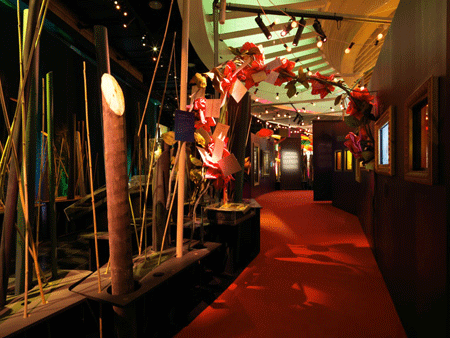
Garden canes and rustic posts define the Art pathway of
Wonderland — The Magic of the Rose
Auckland Museum
The Auckland War Memorial Museum, despite its full name, covers much more than military history. It is a contemporary
Wunderkammer — New Zealand's largest multidisciplinary museum in terms of collections. Its current premises were opened in 1929 as a civic institution housing the collections of the Auckland Institute and commemorating the fallen from the First World War. To honour the armed services of the Second World War the building was enlarged in 1960. A 12-year development program, completed in December 2006, provided new exhibition facilities fitted out to international standards. Auckland Museum emerged better placed to attract prestigious touring exhibitions competing for 'sole New Zealand venue' status. After launching the temporary exhibition hall with one home-grown travelling exhibition[
1] and a couple of overseas shows, a new regime in 2007 altered the course for public programming.
Secrets Revealed — The Backstage Mysteries of your Museum (2008)[
2] signalled an intention to generate 'world class' exhibitions in-house, drawing principally on the Museum's cross-disciplinary holdings. Drama in both the gallery setting and the associated on-line component were designed to broaden the audience profile. The exhibitions reviewed here were part of this program.
Mystery and magic in the plant kingdom
Over ten months in 2009 and 2010, a pairing of consecutive exhibitions shared the same basic installation:
Wonderland — the Mystery of the Orchid and
Wonderland — the Magic of the Rose[
3]. Always up for new experiences, I was ready to encounter both the mystery and the magic, and to keep an eye out for the White Rabbit.
Each exhibition explored its floral theme through two lenses — a natural science focus and an art focus. The scientific approach explained the life cycle and botanical diversity of each genus, alongside various horticultural interventions through the breeding and hybridisation. The art side aimed to present the flowers' artistic appeal across time and across cultures, evoking, respectively, the orchid's mystery and the rose's magic. Objects from the decorative arts and social history collections, including costumes and textiles, supported these themes, with other natural history specimens featuring occasionally as set-dressing.
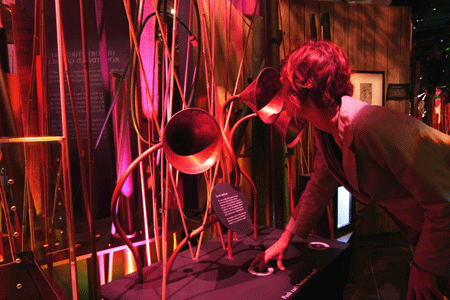
Have a sniff of this! A visitor tries the scent station in
Wonderland — The Magic of the Rose
Auckland Museum
Orchids and roses each have their own enthusiasts — the Museum aimed to exploit the flowers' charms through (mostly) its own collections and a generous sprinkling of whimsy. New Zealand has many native orchids and introduced species are prized by local orchid lovers. There are no native members of the genus
rosa, but these popular flowers are well established in New Zealand gardens; the
Rose exhibition duly honoured Sam McCreedy, New Zealand's pioneering breeder, and Nancy Steen, whose passion for heritage roses led to their revival. Horticulture proved the inspiration for the overall design — garden canes, hose-pipes and watering cans dominated the installation, defining routes and sections, acting as screens, protecting some exhibits and serving as a backdrop.
Both exhibitions used a plethora of media and techniques beyond the traditional museum labels. Videoed interviews and historic footage in nature's realm contrasted with filmed fashion shows and commissioned videos featuring New Zealand performer, Mika, in the art domain. Poetry and love songs contributed to the soundscapes for the Rose show, but these are better enjoyed through the website as the exhibition spaces suffered from 'noise bleed'. Both exhibitions shared scent stations, a beehive with live bees and computer interactives. The finale for Orchid's scientific pathway was a massed display of flowering orchid plants stacked high in pots (loaned from orchid breeder Ross Tucker and the Winter Gardens, and maintained by their staff). Unable to compete with live specimens, the Rose show went over the top in its art section with giant crepe paper blooms (had Alice's playing cards been at work?) and rose petals; a specially commissioned memento mori and jewellery incorporating decaying rosebuds underlined the flower's fleeting glory. The short performance videos telling stories around orchids and roses were unsettling for the squeamish — yes, that does include me. I could see that I wasn't the only visitor disturbed by tears of blood running slowly down the actor's white face.
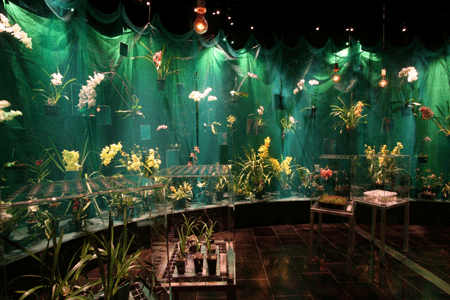
Live orchids displayed behind draped garden netting provide the finale for the nature pathway of
Wonderland — The Mystery of the Orchid
Auckland Museum
Graphics dominated the scientific pathways of both exhibitions. Here were world distribution maps, a myriad images the size of seed packets showing the diversity of plant forms, silk-screened banners and panels, extracts from texts tantalisingly incomplete, and celebrity portrait photographs on large plant tags to illustrate the naming of new rose breeds. To contrast the different ways that bees and humans view colours, two parallel sets of rose images on cards arranged in clusters were displayed in two angled showcases. Many illustrations and captions were mounted on thin uprights, like plant labels in botanical gardens.
'Curiouser and curiouser'
But tell us about the objects? You haven't really mentioned any yet, I hear you say. Well, that's because they were somewhat upstaged by the theatrical setting, and sometimes they were themselves used as props. Visitors entering the exhibition gallery encounter two large vitrines, with costumes on headless mannequins (the Queen of Hearts must have been here) — my favourite wore a trouser suit made of Astroturf — surrounded by other museum specimens with some botanical association. Teacups with floral designs were mounted on 'stalks', suggesting ceramic garden beauties; smaller stalks supported buttons or jewellery. A silk kimono was displayed with its long sleeves echoing the sculptural form of an orchid flower. Other costume items — floral bikinis, designer shoes, hats — and extravagant vases and decorative arts contributed to the pot pourri.
Perched among these, or just grazing, were specimens from the zoology collections. A trophy mounted creature appeared as the head of one costume dummy. A white swan curved its elegant neck. A hare crouched in the undergrowth. Birds hung, frozen in flight, here and there. I looked in vain for hedgehogs, flamingos and the dormice. But wait, what are those extraordinary plants lurking there? They are real museum specimens — finely painted scaled-up models of botanical details, crafted in the late nineteenth century in Germany, and acquired by Auckland University for teaching botany students. I was very taken by these and wanted to know more. To me, their use as props was a lost opportunity to feature such happy conjunctions of art and botany.
The fork in the road
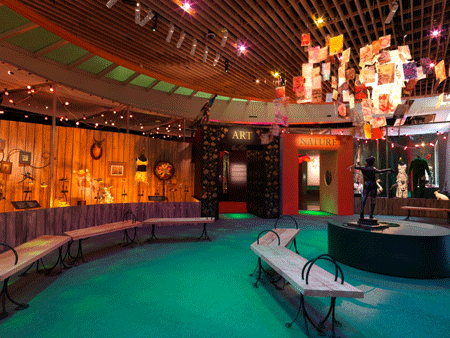
'Would you tell me, please, which way I ought to go from here?'
Decision point: the two pathways beckon in
Wonderland — The Magic of the Rose. The Astroturf trouser suit can be seen at the extreme right, alongside the albino hare.
Auckland Museum
Between the large vitrines, two archways vied to take you to Art or Nature. Nature had the longer pathway but fewer museum specimens. For
Orchids, there were a couple of drawers of insects, delicate botanical drawings and some herbarium specimens. Not just any old ones, though: Banks and Solander had collected these in New Zealand — definitely a goosepimply moment. The art path for
Roses was object-rich by comparison. I loved the copper still for distilling attar of roses. A giant birdcage — or was it a pergola? — held captive a gorgeous Regency-period dress embroidered with rosebuds. Elaborately framed showcases held jewellery, and small decorative
objets, with a light scattering of rose petals. My inner collection manager bridled at one coffin-like case where a dress laid horizontally on crumpled satin was folded against one end with several smaller objects laid on top of it. Thank goodness for the soothing effects of a charming seventeenth-century portrait,
A Man with a Child.[
4]
The twin pathway concept was more straightforward than Alice's exchange with the Cheshire Cat suggests. The approach has been tried before at Auckland Museum: its New Zealand Wars gallery at the start of the Scars on the Heart exhibition presents two narratives — Maori and Pakeha (non-Maori) — about the colonial conflicts of the 1840s and 1860s. It is arguably more successful because the parallel accounts converge in a strong audiovisual program that focuses on the action and the human costs to both sides, and you easily cross the gallery to compare the respective stories and objects at your own pace.
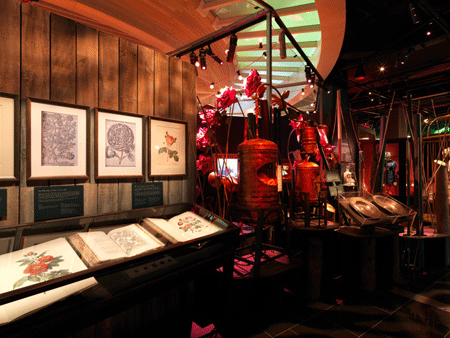
Distilling the natural essence of roses in
Wonderland — The Magic of the Rose — a view from the nature route through to the art pathway
Auckland Museum
Inevitably, both routes brought you to an exhibition shop. The stacks of flower-themed merchandise made me think my adventures in wonderland had led me to a National Trust property in England. This, together with the accompanying program of events, which included gift wrapping and table setting, reinforced my impression of a target demographic with both money and time to spare.
'Everything's got a moral if only you can find it'
The Auckland Museum deserves a bouquet for trying something new.[
5] The double use of a highly staged installation is a worthwhile experiment in budget-conscious times, and may have offset the costs of involving overseas theatre designers. However, the second show,
Roses, suffered from the lack of flexibility imposed by the visitor flow pattern. The greater quantity of rose-related art objects would have 'blossomed' in the space allocated to the Nature path —they were definitely cramped and thus not shown to best effect.
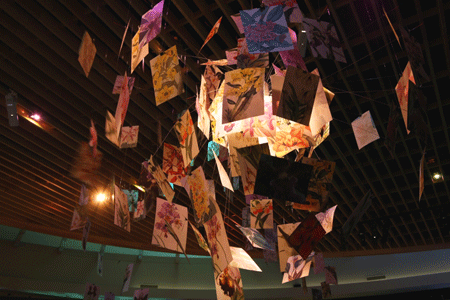
An
Alice in Wonderland moment – 'The whole pack rose up into the air' – a ceiling installation in
Wonderland — The Mystery of the Orchid
Auckland Museum
For me, and according to the visitor figures,
Orchids was the more successful theme. Orchids' many forms, their longer flowering, and various strategies to attract unique pollinators, as well as their relative unfamiliarity meant that I left feeling that I had gained some new knowledge. The Museum had installed a self-complete computer visitor survey unit by the exit of the
Roses exhibition. Visitors were offered a choice of words to associate with their experience, including 'confusing' and 'beautiful'. I expect that there were many visual clues in the exhibitions which were probably too subtle for me, and making a personal association between the titles and Alice's adventures may have led me astray. I was left with plenty to wonder about. Despite this possible confusion, aspects of the exhibitions were beautiful, and there are exquisite elements to the websites which illustrate the strong aesthetic and demonstrate again how exhibitions can have a life long after the installation has been dismantled.
Jane Legget is a senior lecturer in the Department of Tourism and Event Management and Associate Director (Cultural Heritage) at the New Zealand Tourism Research Institute at Auckland University of Technology.
| Exhibition: |
Wonderland — The Mystery of the Orchid and Wonderland — The Magic of the Rose
|
| Institution: | Auckland War Memorial Museum |
| Curatorial team: | Rachael Davies and in-house exhibition team |
| Exhibition space: | 870 square metres |
| Dates: | 3 July – 8 November 2009
and 4 December 2009 – 16 April 2010
|
|
Websites:
|
www.aucklandmuseum.com/?t=1039 and www.aucklandmuseum.com/?t=1313
|
|
|
1 Chris Ballard, Voyages of the Pacific Ancestors: Vaka Moana (review), reCollections, vol. 4, no. 2 http://recollections.nma.gov.au/issues/vol_4_no_2/exhibition_reviews/vaka_moana.
2 The Secrets Revealed homepage is at www.aucklandmuseum.com/?t=704.
3 The exhibition websites can be seen at www.aucklandmuseum.com/?t=1039 (The Mystery of the Orchid) and www.aucklandmuseum.com/?t=1313 (The Magic of the Rose).
4 By Carlo Ceresa (1601–1697), loaned from the collection of Auckland Art Gallery, www.aucklandartgallery.govt.nz/the-collection/browse-artwork/9703/a-man-with-a-child.
5 The Museum's commendable preparedness to invest in experiments is seen in an associated display of botanical treasures from the Museum's library: Illustrated Leaves: Florilegia from the 16th to the 21st Centuries (www.aucklandmuseum.com/1122/illustrated-leaves) and in its Sonic Museum (www.aucklandmuseum.com/?t=1005). Visitors to Illustrated Leaves can virtually turn the pages of the books displayed using small screens incorporated into the exhibition cases. Sonic Museum invited contemporary New Zealand musicians to respond to some of the permanent galleries, with visitors able to listen to the resulting compositions by downloading them to their portable media players.






